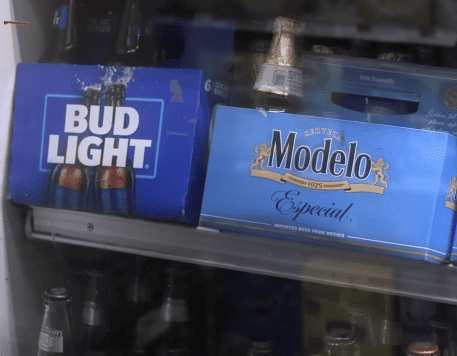How Modelo became the best-selling beer in the United States

In our textbook, we stay away from references and images of alcohol. We know that some instructors prefer not to expose their students to any more vices than necessary. Other instructors find that relating to a market most students actually know pretty well helps marketing concepts stick. Since the blog here lets you choose what ideas to bring to your classroom and students, I decided to share this case study on the beer brand Modelo. I find the story to be an interesting case study.
Between this Wall Street Journal article and their video embedded below (and shown here), we learn about some of the history that led to a changing of the guard in the beer industry.
In some ways, this opportunity was opened up by a decision by the U.S. Justice Department to oppose a proposed merger between AB InBev (owner of Budweiser brands and others) Grupo Modelo (owner of Corona and Modelo). A 2013 settlement required AB InBev was forced to divest Modelo’s U.S. business. This set the stage for the brand to compete more directly with Bud Light. And Modelo did just that.
Modelo Especial surpassed Bud Light in dollar sales in May. This change in ranking was influenced by an antitrust decision almost a decade ago (that one is covered more in the video), demographic shifts, changing consumer preferences, effective marketing, and a recent cultural controversy surrounding Bud Light.
Bud Light faced a significant sales drop this spring following a boycott. The boycott was sparked by a social media post from transgender influencer, Dylan Mulvaney, showcasing a personalized Bud Light can gift. This, coupled with Anheuser-Busch InBev’s response, led to a decline in sales of several Anheuser-Busch brands including Bud Light.
In contrast to Bud Light’s decline, Modelo has been on an upward trajectory, driven by several factors:
- Demographics: Modelo has found significant popularity among the growing Hispanic population in the U.S.
- Consumer Trends: Modelo, positioned as a more premium beer than many American light lagers, benefited from consumers gravitating towards pricier drinks.
- Marketing: Constellation, which has had the U.S. license for Modelo since 2013, aggressively marketed the brand, notably with the “The Fighting Spirit” campaign. Modelo also worked hard to get better retail presence.
While Modelo has historically had a large Hispanic consumer base (70% in Constellation’s 2019 fiscal year), it has been working to broaden its appeal. By the end of 2021, 45% of Modelo’s consumer base was non-Hispanic. It’s now a leading brand in several U.S. regions, including California and cities like Chicago, Dallas, and Baltimore.
Despite Modelo’s recent success, Bud Light’s sales for the first five months of this year remain higher overall. However, some Bud Light distributors believe that Bud Light’s top position might be lost for good. In response to the sales drop, AB InBev has offered financial assistance to its distributors and plans to introduce new Bud Light advertisements with themes of football and country music.
How this case study in your marketing class
I need to acknowledge ChatGPT’s help in putting together a list of ideas for adding this to your marketing class.
- Case Study Analysis: (Chapters 2 – strategy, 3 – competition and legal, 12 – retail distribution, and 19 – marketing plan). The article provides a comprehensive real-world case of brand rivalry and market dynamics. Professors can present this as a case study, prompting students to analyze the factors that led to Modelo’s rise and Bud Light’s decline.
- Understanding Market Shifts: (Chapter 3) Discuss the importance of understanding and adapting to demographic changes, exemplifying how Modelo catered to the growing Hispanic population in the U.S. and broadened its appeal to a wider audience.
- Brand Positioning: (Chapters 4 and 8) Highlight how Modelo positioned itself as a more premium product, benefitting from the trend of consumers moving towards more expensive drinks. This can lead to a broader discussion on pricing strategies and product differentiation.
- Role of Advertising: (Chapter 15) Analyze Modelo’s “The Fighting Spirit” campaign. Discuss its themes, target audience, and effectiveness. This can be contrasted with Bud Light’s planned advertisement approach focusing on football and country music.
- Consumer Behavior: (Chapter 5) Explore the factors that influence consumer preferences. For instance, why did consumers gravitate towards Modelo over Bud Light, and how do sociocultural trends impact beverage choices?
Incorporating this article into the curriculum provides students with a tangible, current example of the complexities of marketing, allowing them to apply theoretical knowledge to real-world situations.
